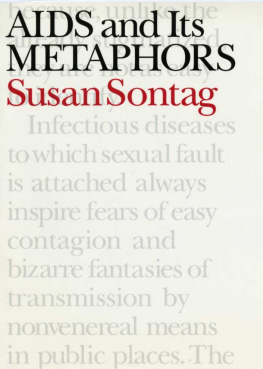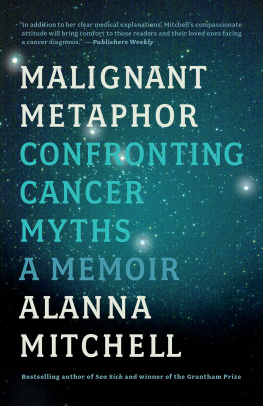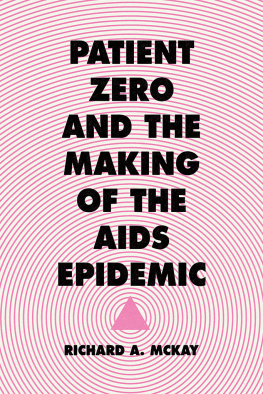By metaphor I meant nothing more or less than the earliest and most succinct definition I know, which is Aristotles, in his Poetics (1457b). Metaphor, Aristotle wrote, consists in giving the thing a name that belongs to something else. Saying a thing is or is like something-it-is-not is a mental operation as old as philosophy and poetry, and the spawning ground of most kinds of understanding, including scientific understanding, and expressiveness. (To acknowledge which I prefaced the polemic against metaphors of illness I wrote ten years ago with a brief, hectic flourish of metaphor, in mock exorcism of the seductiveness of metaphorical thinking.) Of course, one cannot think without metaphors. But that does not mean there arent some metaphors we might well abstain from or try to retire. As, of course, all thinking is interpretation. But that does not mean it isnt sometimes correct to be against interpretation.
Take, for instance, a tenacious metaphor that has shaped (and obscured the understanding of) so much of the political life of this century, the one that distributes, and polarizes, attitudes and social movements according to their relation to a left and a right. The terms are usually traced back to the French Revolution, to the seating arrangements of the National Assembly in 1789, when republicans and radicals sat to the presiding officer's left and monarchists and conservatives sat to the right. But historical memory alone can't account for the startling longevity of this metaphor. It seems more likely that its persistence in discourse about politics to this day comes from a felt aptness to the modern, secular imagination of metaphors drawn from the body's orientation in space left and right, top and bottom, forward and backwardfor describing social conflict, a metaphoric practice that did add something new to the perennial description of society as a kind of body, a well-disciplined body ruled by a head. This has been the dominant metaphor for the polity since Plato and Aristotle, perhaps because of its usefulness in justifying repression. Even more than comparing society to a family, comparing it to a body makes an authoritarian ordering of society seem inevitable, immutable.
Rudolf Virchow, the founder of cellular pathology, furnishes one of the rare scientifically significant examples of the reverse procedure, using political metaphors to talk about the body. In the biological controversies of the 1850s, it was the metaphor of the liberal state that Virchow found useful in advancing his theory of the cell as the fundamental unit of life. However complex their structures, organisms are, first of all, simply multicellularmulticitizened, as it were; the body is a republic or unified commonwealth. Among scientist-rhetoricians Virchow was a maverick, not least because of the politics of his metaphors, which, by mid-nineteenth-centuiy standards, are antiauthoritarian. But likening the body to a society, liberal or not, is less common than comparisons to other complex, integrated systems, such as a machine or an economic enterprise.
At the beginning of Western medicine, in Greece, important metaphors for the unity of the body were adapted from the arts. One such metaphor, harmony, was singled out for scorn several centuries later by Lucretius, who argued that it could not do justice to the fact that the body consists of essential and unessential organs, or even to the bodys materiality: that is, to death. Here are the closing lines of Lucretius' dismissal of the musical metaphorthe earliest attack I know on metaphoric thinking about illness and health:
Not all the organs, you must realize,
Are equally important nor does health
Depend on all alike, but there are some
The seeds of breathing, warm vitality
Whereby we are kept alive; when these are gone
Life leaves our dying members. So, since mind
And spirit are by nature part of man,
Let the musicians keep that term brought down
To them from lofty Heliconor maybe
They found it somewhere else, made it apply
To something hitherto nameless in their craft
I speak of harmony. Whatever it is,
Give it back to the musicians.
De Rerum Natura, III, 124-35
trans. Rolfe Humphries
A history of metaphoric thinking about the body on this potent level of generality would include many images drawn from other arts and technology, notably architecture. Some metaphors are anti-explanatory, like the sermonizing, and poetic, notion enunciated by Saint Paul of the body as a temple. Some have considerable scientific resonance, such as the notion of the body as a factory, an image of the bodys functioning under the sign of health, and of the body as a fortress, an image of the body that features catastrophe.
The fortress image has a long prescientific genealogy, with illness itself a metaphor for mortality, for human frailty and vulnerability. John Donne in his great cycle of prose arias on illness, Devotions upon Emergent Occasions (1627), written when he thought he was dying, describes illness as an enemy that invades, that lays siege to the body-fortress:
We study Health, and we deliberate upon our meats, and drink, and ayre, and exercises, and we hew and wee polish every stone, that goes to that building; and so our Health is a long and a regular work; But in a minute a Canon batters all, overthrowes all, demolishes all; a Sicknes unprevented for all our diligence, unsuspected for all our curiositie....
Some parts are more fragile than others: Donne speaks of the brain and the liver being able to endure the siege of an unnatural" or rebellious" fever that will blow up the heart, like a mine, in a minute." In Donnes images, it is the illness that invades. Modem medical thinking could be said to begin when the gross military metaphor becomes specific, which can only happen with the advent of a new kind of scrutiny, represented in Virchows cellular pathology, and a more precise understanding that illnesses were caused by specific, identifiable, visible (with the aid of a microscope) organisms. It was when the invader was seen not as the illness but as the microorganism that causes the illness that medicine really began to be effective, and the military metaphors took on new credibility and precision. Since then, military metaphors have more and more come to infuse all aspects of the description of the medical situation. Disease is seen as an invasion of alien organisms, to which the body responds by its own military operations, such as the mobilizing of immunological defenses," and medicine is aggressive, as in the language of most chemotherapies.
The grosser metaphor survives in public health education, where disease is regularly described as invading the society, and efforts to reduce mortality from a given disease are called a fight, a struggle, a war. Military metaphors became prominent early in the century, in campaigns mounted during World War I to educate people about syphilis, and after the war about tuberculosis. One example, from the campaign against tuberculosis conducted in Italy in the 1920s, is a poster called Guerre alle Mosche (War against Flies), which illustrates the lethal effects of fly-borne diseases. The flies themselves are shown as enemy aircraft dropping bombs of death on an innocent population. The bombs have inscriptions. One says Microbi, microbes. Another says Germi della tisi, the germs of tuberculosis. Another simply says Malattia illness. A skeleton clad in a hooded black cloak rides the foremost fly as passenger or pilot. In another poster, With These Weapons We Will Conquer Tuberculosis, the figure of death is shown pinned to the wall by drawn swords, each of which bears an inscription that names a measure for combating tuberculosis. Cleanliness is written on one blade. Sun on another. Air. Rest. Proper food. Hygiene. (Of course, none of these weapons was of any significance. What conquersthat is, curestuberculosis is antibiotics, which were not discovered until some twenty years later, in the 1940s.)










